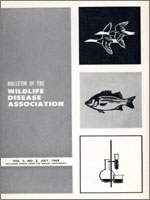Leptospiras isolated from creek water in Iowa at the site of human leptospirosis exposure could not be identified by a reference laboratory but the 31 isolates were placed into 12 serologic groups using serologic cross reactions and agglutinin absorption techniques. Reactions of the isolates to 8-azaguanine and copper sulfate suggest that they belong to the nonpathogenic or saprophytic complex. Cloning procedures failed to detect any leptospires that could be classified as pathogenic or parasitic but did indicate that some isolations from water contained serologically heterogenous populations of leptospires. The possible significance of these results is discussed.
BioOne.org will be down briefly for maintenance on 17 December 2024 between 18:00-22:00 Pacific Time US. We apologize for any inconvenience.
How to translate text using browser tools
1 July 1969
CHARACTERIZATION OF LEPTOSPIRES ISOLATED FROM SURFACE WATERS IN IOWA
RICHARD P. CRAWFORD,
JOHN L. BRAUN,
WILLIAM F. McCULLOCH,
STANLEY L. DIESCH





